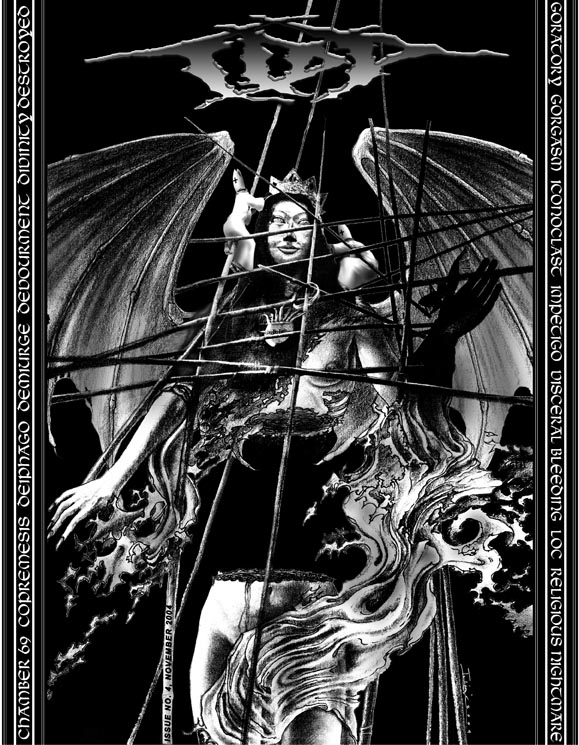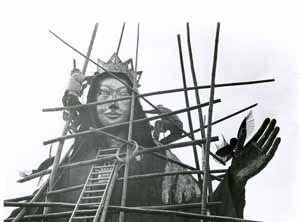
Though created back in 2004, this work is the cover of the 4th issue of arguably the Philippines’ most reputable metal zine: In Dark Purity. Though the gist of my rationale remains unwavering, back at that time I overlooked the possibility of Cultural Assimilation: “The process whereby a minority group gradually adapts to the customs and attitudes of the prevailing culture and customs” (Wikipedia).
I would also like to include my reference picture: The Lady of EDSA under construction –which came from the now defunct TODAY Newspaper’s photo morgue.
Here is the original rationale:
If the Philippines’ mythological creatures such as the manananggal, the tikbalang, the aswang, etc. were truly indigenous, then how come their common deterrents are crucifixes, rosaries, holy water and the likes?
Theoretically speaking, one can only deduce that the introduction of these paranormal pseudo-human beasts came alongside another foreign, yet now overly assimilated concept –Western religion.
“Implanting the Mythos” the title of the work, is a borrowed term from another Western reference (to be expanded upon later). The title however is caustically applied – daresay an attempt in conscious assimilation of a foreign idea, in contrast to swallowing it –hook line and sinker –as the majority of our populace have done with Christianity.
One cannot help but recall one of Karl Marx’s most famous quotations about religion being the opium of the masses. It indeed is one of our society’s plagues. How can one revere a church that condones poverty and overpopulation by saying that every child is a gift from god?
* * *
The term mythos implanting originates from Frank Herbert, the writer of Dune –a series of books that can be deemed significant modern classics.
Dune as one may already know is a desert planet. Its people, though evolved to suit their surroundings lived sparingly in order to survive the parched landscape. And, inspite of physical and technological adaptations to conserve water, life on Dune was still of hardship and extreme prudence.
The missionaries in the story took advantage of the situation by propagandizing the idea that there would be an “off-world” savior, upon whose arrival would turn Dune into a verdant paradise. Before they left the planet, they told the people that the messiah would come specifically in the form of a boy and his mother.
The missionaries themselves did not believe in this “messiah”. Rather, it was a form of insurance for their belief system’s safety, if not propagation, lest any of them get trapped in Dune in the future. The story begins with the circumstances they foresaw, happening hundreds of years later.
This is why Frank Herbert specifically used the term “implanting”.
* * *
The success of any propaganda is based upon necessity. Perhaps the Philippines’ dogmatic grasp on Christianity stems from the implantation of such mythos as the manananggal etc. to plague society and arouse a need for the church.
In Dune, the missionaries’ job was much simpler because the need was already there. In the Philippines’ case, there was no need, so the missionaries had to create one – after all, it took 43 more years after Magellan set foot on our soil for the Philippines to be colonized.
It’s food for thought.

